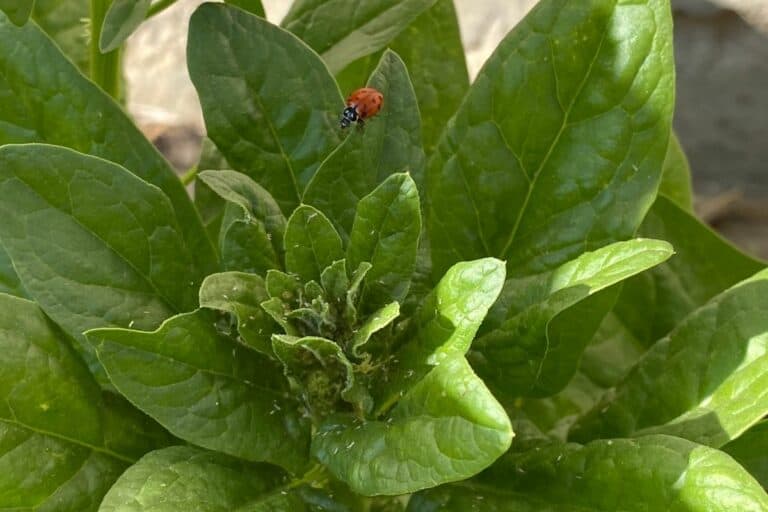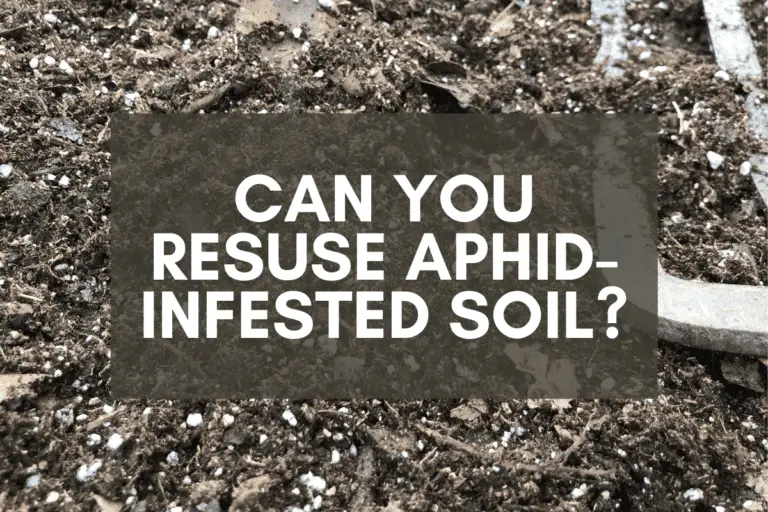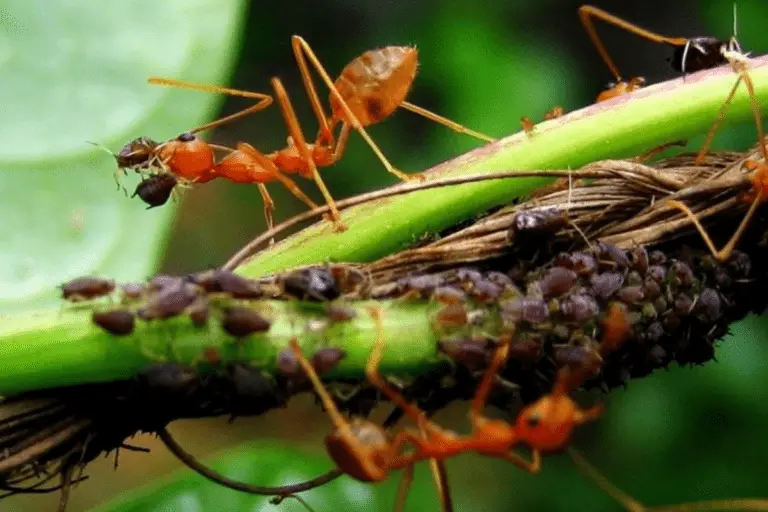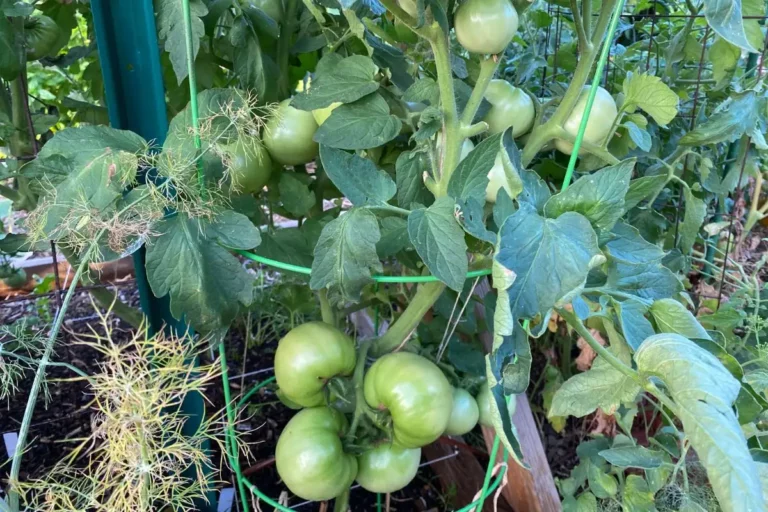Are Aphids Black? How to Identify and Stop Black Aphids
If you’ve been gardening for any time at all, you’ve likely had aphids in your garden, even if you didn’t realize it at the time. These little pests show up out of nowhere, reproduce exponentially, and cluster around your plants’ leaves and flowers.
If you’ve seen clusters of little black bugs on your plants, you might have asked yourself, “Are aphids black?”
Aphids come in a wide range of colors—green, brown, red, white, yellow, gray, even pink and purple—but many aphid species are various shades of black. A few of the more common types of black aphid are black bean, black cherry, black citrus, cabbage, corn leaf, cowpea, and onion aphids.
Unlike spider mites, which are difficult to see unless you know exactly what you’re looking for, aphids are pretty easy to spot. Although you might see a lone aphid now and then, you’ll typically notice small clusters of black, green, red, yellow, or even white bugs, a tell-tale giveaway that you’ve got aphids in your garden.
Because female aphids can reproduce both sexually and asexually (a process known as parthenogenesis) while also giving birth to live young, an aphid infestation can increase quickly in the span of a few weeks. Aphid nymphs typically remain in the same general area as the adults that birthed them, which means that infestations will often remain relatively localized until starvation compels aphids to migrate to different parts of your garden.
Aphids differ in size, shape, and color, but the vast majority of them are 1 mm to 3 mm long and most are various shades of black or green. They’re typically wingless, but food shortages will give rise to winged aphids, which can fly to nearby plants to continue feeding and reproducing.
One final general fact about aphids: Unless you’re an entomologist–or you collect aphids and send them off to a lab–you’ll never know what kind of aphids you’ve got on your property because there are more than 4,700 aphid species.
But here’s good news for those of us interested in keeping our gardens free of aphids: Unlike spider mites–which can ruin whole sections of your garden if you don’t respond quickly and aggressively for days on end–you can take care of aphid infestations pretty quickly.
There are several easy ways to do so, which I’ll explain in detail below, but as long as you treat the aphid infestation consistently for several days in a row, you’ll take care of the problem.
Here’s a list of black aphids that are most likely to appear in your garden:
| Kind | Color | Size | Distribution |
|---|---|---|---|
| Black Bean Aphid | Dull Black | 1.2 – 2.9 mm | Worldwide |
| Black Cherry Aphid | Shiny Black | 1.8 – 2.6 mm | Africa, Asia, Europe |
| Black Citrus Aphid | Reddish Black | 2 mm | Europe, North America |
| Cowpea Aphid | Brownish Black | 1.1 – 2.3 mm | Worldwide |
| Onion Aphid | Reddish Black | 1.6 – 2.3 mm | Americas, Asia, Europe, |
There are many other black aphid varieties, but they tend to infest trees, bushes, and weeds, not garden plants.
Are Black Aphids Harmful?
The harmfulness of black aphids largely depends on the size and duration of the aphid infestation.
In search of sap, which is their primary food source, black aphids will infest all parts of a plant, although they tend to cluster around flowers and leaves. Black aphids are not very harmful, but if left unattended, they’ll cause foliage decay while also damaging the plant’s flowers and fruit.
Let me explain by giving you a step-by-step rundown of what happened to my plants last year as an illustration of the kinds of harm that aphids can cause.
This is what my okra leaves looked like in July and August. There’s a hint of minor bug damage here and there, but the plant was otherwise perfectly healthy.

In early September, I noticed aphids on a few okra plants. Instead of using one of my proven methods to get rid of them, I decided to see what would happen if I didn’t intervene at all. I knew that cool weather was on the way come October–and that my okra wouldn’t thrive in such conditions anyway–and I wanted to find out what would happen if I just let the aphids do whatever they wanted to do.
Over the course of the next 4 weeks, I noticed several interesting changes to my okra plants.
First, although I eventually found aphids all over the okra plants, they tended to cluster around the plant’s flowers and okra pods, as you can see in the photos below.
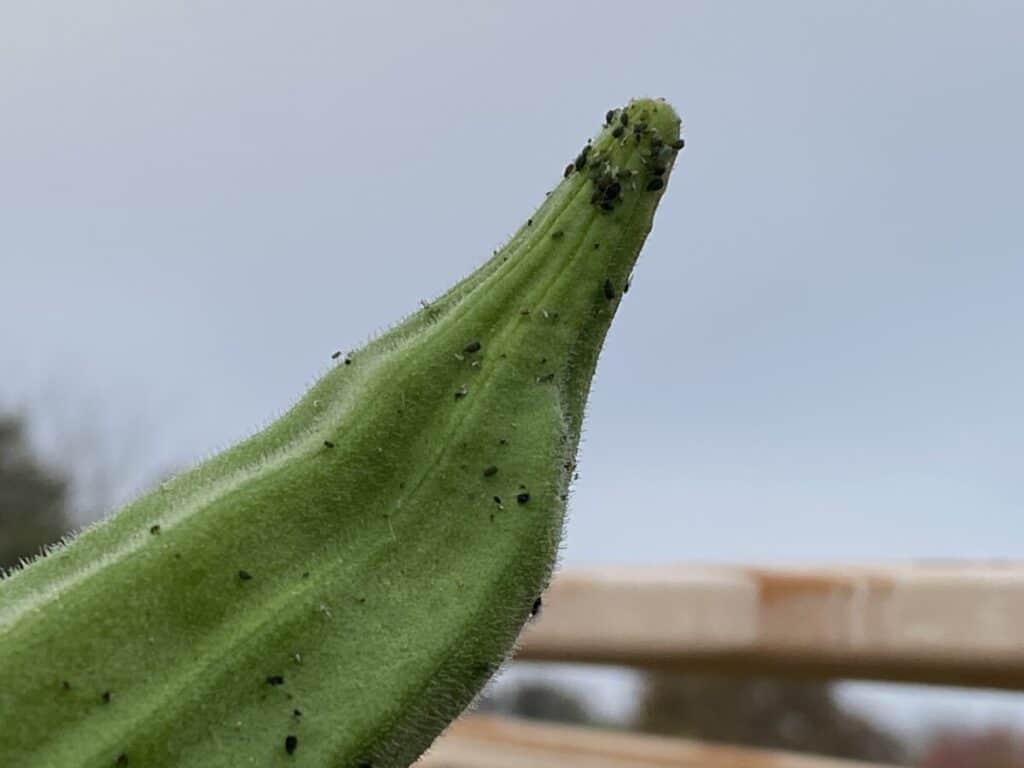
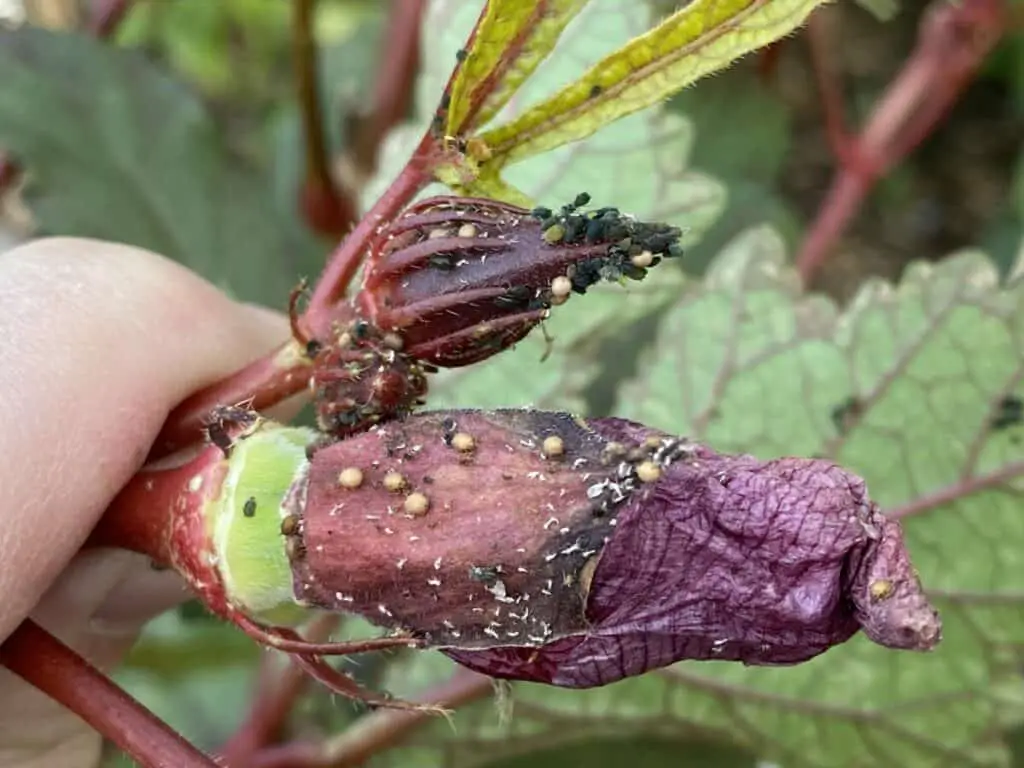
Second, this clustering led to the arrival of ants, another tell-tale sign that you might have aphids in your garden. As aphids feed, they excrete a sugary substance called honeydew, which ants love, so ants will be drawn to aphid infestations.
Unfortunately, in such situations, ants are not your friends. Because they want as much honeydew as possible, ants will kill ladybugs, lacewings, and other beneficial insects before those insects can rid your plant of aphids. If you see ants among your aphids, use one of the methods below to get rid of both.
Third, when left untreated, aphids damaged my okra’s foliage, as you can see in the photos below. The leaves began to yellow–it looked like blotchy yellow patches were spreading across the plant–and the leaves also began to show signs of decay. Dry, brown patches began appeared up and down each leaf as the aphids sucked the sap from the plant.
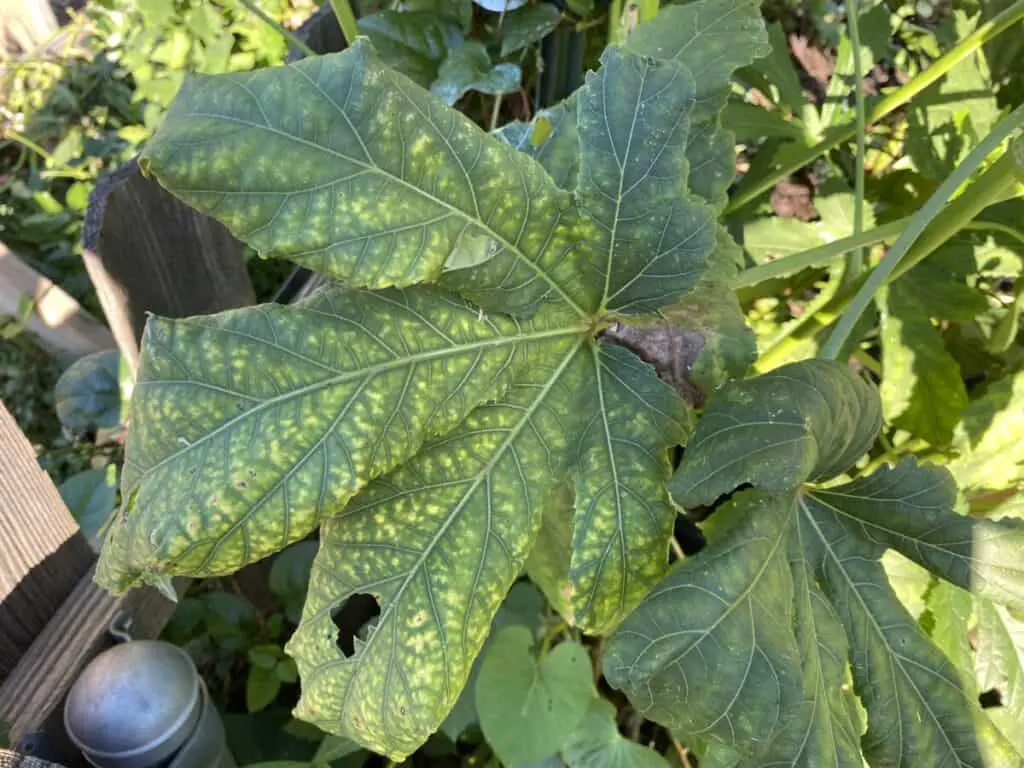

This process took several weeks–and to be honest, it didn’t seem to slow down the plant’s overall pod production–but by the time I yanked out my okra plants to replace them with winter varieties, they looked ugly and worn out.
Fourth, as anyone who’s grown okra knows, okra pods grow incredibly fast, so when aphids pierced the skin of the pods in search of sap, the damage they left behind resulted in the development of little bumps that formed along the length of the pod.
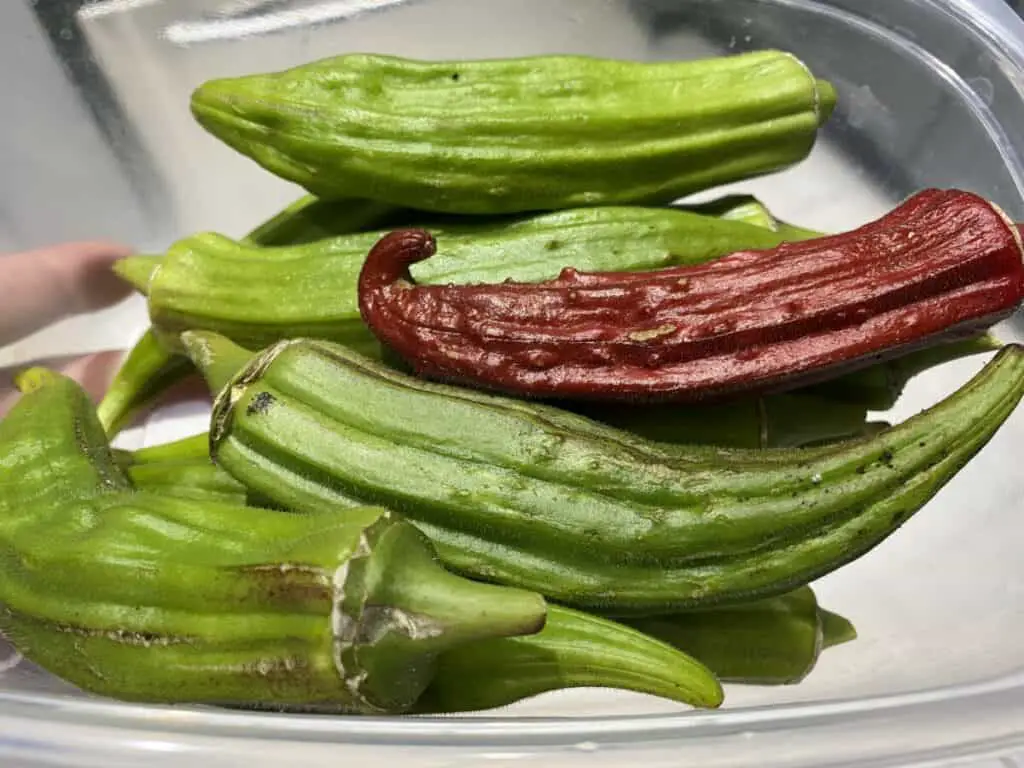
Thankfully, these bumps didn’t affect the okra’s overall taste, but they were somewhat unsightly.
Finally, as the aphids clustered on the okra pod, they tended to cause the most damage around the area where the pod meets the stem. In fact, it looked to me that, due to the damage caused when they clustered together, they had shorn the pod’s outer skin in certain localized areas. This damage meant that portions of the pod looked downright unappetizing.
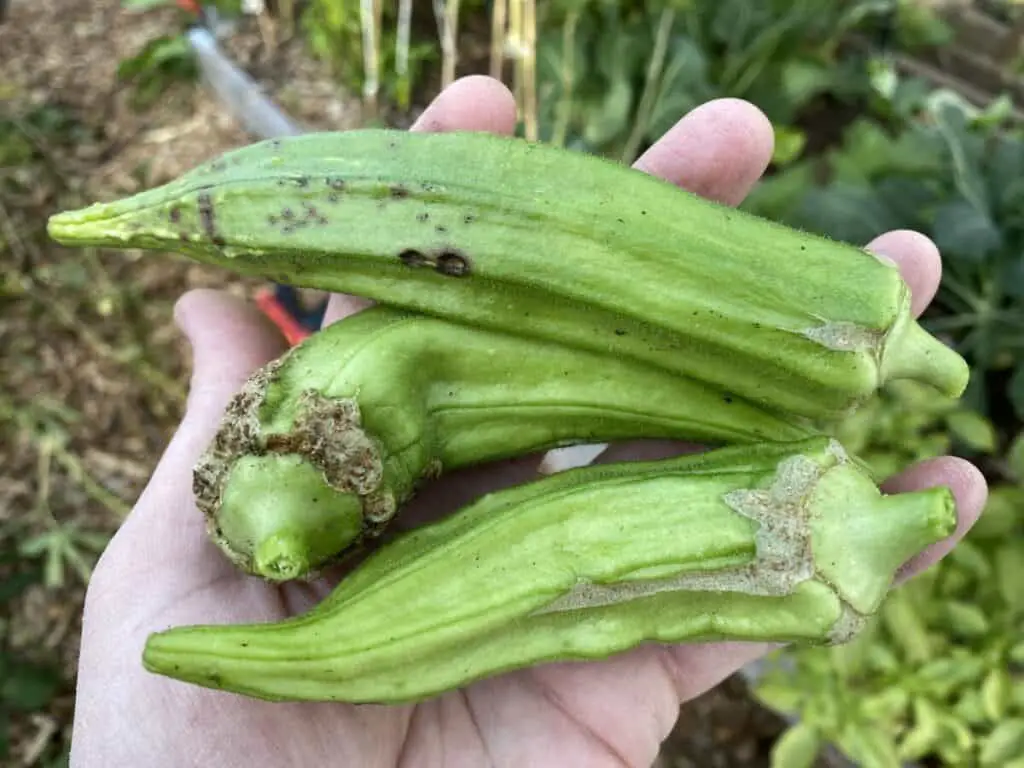
Fortunately, when it came time to harvest and cook the pods, I simply sliced off the shorn areas, and everything else tasted just as I had expected it to taste.
In other words, aphids damaged my okra but it was relatively minor damage. I don’t think I’ll let them go wild again–especially since I saw winged aphids, which meant they were migrating to other parts of my garden–but I won’t worry too much either. Whenever I see them, I’ll simply use one of the methods below to get rid of the infestation.
How Do I Get Rid of Black Aphids?
Here’s the great thing about aphids: They’re easier to kill than most garden pests, especially when compared to cabbage worms, cucumber beetles, leaf-footed bugs, spider mites, or white flies.
The simplest way to get rid of black aphids is to spray them with a garden hose since jets of water will damage aphids’ fragile exoskeletons. For growing infestations, the best approach is to spray plants with a homemade insecticide made of neem oil, soapy water, liquid seaweed, or essential oils.
When I suggest that water is the “simplest” way to get rid of black aphids, I’m not saying it’s the best overall method since I typically prefer other methods over water. But if you notice a few aphids on a leaf or flower, a quick blast of water could be all you need to take care of the problem before it worsens.
If you’re dealing with a more advanced infestation–one where you’ve got aphids on multiple branches or clusters of aphids grouped around flowers or foliage–I recommend a more aggressive treatment plan.
Any of the methods listed below will take care of most aphid infestations in 5-7 days. Here are my suggested treatments in order of preference:
1. Neem Oil
This is my favorite treatment method when combating a variety of garden pests.
Neem oil is derived from neem seeds, and in its concentrated form, it’s brown, thick, and rather pungent. But when you mix concentrated neem oil with a small amount of soap and the right amount of water, you’ll have an amazing natural insecticide that’s incredibly effective against black aphids.
In my article on using neem oil to kill spider mites, I’ve laid out everything you need to know when it comes to preparing and using a general-purpose neem oil spray. But I’ll provide a basic overview below for your convenience.
To make an effective neem oil spray, simply fill a 1-gallon sprayer with water, then combine 2 tablespoons of neem oil concentrate with 1 tablespoon of a soapy emulsifier and mix all ingredients together.
The emulsifying agent will allow the oil and water to mix so that everything’s properly diluted. After that, you’ll need to spray your plants thoroughly, covering all sites of infestation. Just don’t forget to spray the undersides of the leaves since aphids will sometimes hide there.
2. Soapy Water
Not quite as powerful as neem oil–but still powerful enough to kill black aphids–a soapy water spray is a great option for the everyday gardener, especially if you’ve run out of neem oil and need something that will do the trick in the meantime.
All you need to do is this: Mix 5 tablespoons of soap with 1 gallon of water. I prefer to use an organic liquid soap, a peppermint castile soap, or an insecticidal soap. Add the water first to a 1-gallon sprayer, then pour in the soap, and shake well.
Once you’ve got your soapy spray prepped, be sure to spray all visible black aphids as well as any foliage that looks damaged in any way. As with neem oil, you’ll need to spray both the top of the foliage as well as the undersides of all leaves to ensure that you don’t miss any aphids.
Soapy water must coat aphids to kill them, so be sure to apply it liberally and do so on consecutive days to guarantee that surviving aphids don’t have time to reproduce and reinfest your plants.
3. Water
For those interested in the easiest, most cost-effective approach to getting rid of aphids, all you need is a water hose with a nozzle and decent water pressure. Turn the nozzle to either the “full” or “jet” setting, aim the hose at the black aphids, and blast them with a steady stream of water.
At the very least, the aphids will be blown off your plant, but in many cases, the jet of water will have enough pressure to damage aphids’ exoskeletons, killing them either immediately or within a short period of time.
To be clear, I only use water on very small aphid infestations because I don’t like blasting my plants with jets of water. For larger infestations, I wouldn’t recommend this approach since you’d have to spray the entirety of your plant with jets of water to be effective. In doing so, you might damage your plant, and you’ll also be wasting water throughout the process.
But there’s one exception: If you’ve got small potted garden plants, a quick shower might take care of the infestation.
4. Liquid Seaweed
I like liquid seaweed for two main reasons. First, when mixed properly, it’s an effective natural insecticide that kills quite a few nasty garden pests. Second, liquid seaweed is packed with nutrients, which plants are able to absorb through their foliage.
In other words, as you spray to kill off aphids, you’re also fertilizing your plants, so using liquid seaweed is a win-win scenario.
To create an effective foliar spray, simply mix 1-2 ounces of liquid seaweed per gallon of water and use the “mist” setting on your sprayer nozzle to cover the entirety of your plant with a thin layer of liquid seaweed. Be sure to spray the undersides of all foliage and give an extra spray to any visible black aphids to guarantee that they’re coated in the liquid seaweed solution.
5. Essential Oils
Much like neem oil, an essential oils spray will coat black aphids in a layer of oil that’ll disrupt their biological and reproductive processes. The key with this approach is to only use what’s necessary since essential oils can get a bit pricey.
For smaller infestations, I recommend using a small spray bottle and mixing the following ingredients together: 3/4 teaspoon of essential oils + 1 teaspoon of liquid soap + 16 ounces of water. For larger infestations, you’ll want to mix 2 tablespoons of essential oils with 5-6 tablespoons of soap and 1 gallon of water.
As you can see, this spray is similar to the soapy water spray but more effective due to the addition of essential oils. However, it’s also pricier.
If cost isn’t your top priority, an essential oils spray will effectively neutralize black aphids. For added convenience, you can even buy pre-made sprays such as Dr. Earth Final Stop: Vegetable Garden Insect Killer, which uses numerous essential oils.
But if you’re looking to keep costs as low as possible, I’d recommend trying a soapy water or neem oil spray first since they’re more cost-effective overall.
6. Liquid Molasses
Derived from sugar, liquid molasses is another multi-purpose product. It’ll kill garden pests while simultaneously providing nutrients to both your plants and the surrounding soil.
I’ve had success with this product when I’ve mixed 1-2 tablespoons of liquid molasses per gallon of water. When combating spider mites, I always use 2 tablespoons, but for black aphids, I think 1 tablespoon should work just fine.
Unlike some of the sprays mentioned above, you wouldn’t want to spray liquid molasses on your plants more than once every 6-7 days. What I’d suggest is this: Spray liquid molasses on your plants on the first day, then use a soapy water spray for the next 5-6 days.
What Insects Eat Black Aphids?
If you’re hoping that Mother Nature will step in and help remedy your aphid infestation, you’ll want to keep your eyes out for certain beneficial bugs.
Aphids have several natural predators: assassin bugs, damsel bugs, hover fly larvae, ladybugs, lacewing larvae, minute pirate bugs, and praying mantises. Beneficial insects lay eggs in the vicinity of aphid infestations to ensure their newly-hatched larvae have access to plentiful food sources.
Unlike lacewings and hover flies, ladybugs will continue to feast on aphids even after they’ve matured from their larval stage to their adult stage. One of the most amazing facts about ladybugs is this: Assuming easy access to aphids, a single ladybug can eat 5,000 aphids over the course of its lifetime!
If you don’t see any of these bugs in your garden, you can purchase bulk ladybugs from online retailers or even buy multipacks that contain both ladybugs and lacewing eggs.
Just keep this in mind: If you release beneficial insects in your garden, there’s no guarantee that they’ll remain there. If they sense better food sources on other nearby properties, they’ll likely leave within a few days.
You also can’t use any foliar sprays if you’ve just released ladybugs or lacewings. If you do, you’ll kill the black aphid pests along with the beneficial bugs you’ve just released. Instead, give the bugs a week or two to do their work. If the aphid infestation remains, the bugs have likely left your property, so you’ll need to try one of the methods noted above to kill any remaining black aphids.
Why Are Aphids Different Colors?
There are over 5,000 different aphids species scattered across every continent but Antarctica, which means this insect species is as varied as they come. But if you’ve seen aphids, chances are that you first noticed their distinct coloration.
Black, green, white, gray, red, brown, purple, yellow, pink: aphids come in all of these colors. In fact, many aphids can even change color as they mature from newly-hatched nymphs to full-grown adults or as they interact with their environment.
For example, aphids are highly susceptible to changes in food sources, especially when such changes result in stress or starvation. Light intensity can also cause aphids to change color, which can be as drastic as a shift from green to brown or even pink, as a study of the English pea aphid demonstrated.
A groundbreaking study published in the journal Science in 2010 revealed that aphids have integrated carotenoids–the molecules that produce vibrant colors in carrots, corn, pumpkins, and tomatoes–into their DNA through a lateral gene transfer with fungi. Simply put, at some point in time, ancient aphids ate ancient fungi and somehow incorporated the fungi DNA into their genome, then managed to continue reproducing with those fungi genes intact.
In other words, much like many popular garden plants, aphids have, within their little bodies, the ability to create their own carotenoids, which is a major reason why aphids across the world have so many distinct colorations.
If you’d like to learn more about the aphid life cycle and its impact on your garden, check out my articles on recognizing and killing green aphids and spotting and getting rid of white aphids.
Special thanks to the folks at Influential Points for providing insights about the lengths of particular aphid species.


